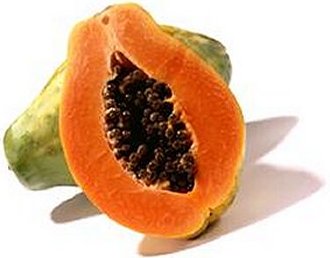Sandbox 31
From Proteopedia
>
| Please do NOT make changes to this Sandbox. Sandboxes 30-60 are reserved for use by Biochemistry 410 & 412 at Messiah College taught by Dr. Hannah Tims during Fall 2012 and Spring 2013. |
Contents |
Papain (PDB ID #: 9pap)
|
Introduction
Papain is a cysteine hydrolase (EC 3.4.22.2) that is found naturally occurring in Papaya(Carica papaya). Papain is extracted from the latex, leaves and roots of the papaya tree. Thiol proteases like papain are commonly found in different fruits like pineapples, figs, and kiwis. Proteases are a group of enzymes that cleave peptide bonds of protein molecules. Papain is a protease commonly used for cell isolation, protein structural studies, cleaving antibodies, and various other research techniques. In addition to use in research, it is commonly used in industry to tenderize meats, remove skin from hides, and clean soft contact lenses.
History
Papain was first explorer back in 1873 by G.C. Roy, who studied papaya juice. Later, papain was extracted and named by Wertz and Bouchut who noticed it had proteolytic properties. Papain was the second enzyme to have it's structure determined by x-ray crystallography. Extensive research has be done on the structure and activity of papain and its
Structure
Papain is formed from a peptide that is 212 amino acids in length. It consists of 25% and 21% . The structure also consists of three between . The disulfide bonds exist between Cys 63 and Cys 22, Cys 200 and Cys 153, and Cys 56 and Cys 95. Another important residue to the structure is Cysteine 25 which has a sulfhydryl group that plays a major role in the active site activity[[1]].
The in papain are primarily located toward the inside of the enzyme or paired by hydrophobic interactions with other hydrophobic residues to exclude water. The are located facing the exterior, in the active site, or paired with other charged residues. The charged residues (acidic) and the charged residues (basic) make up the polar residues. The charged and polar residues are hydrophilic therefore do not orient themselves to exclude water or solvent. The charged face outward due to their hydrophilic nature.
Inhibitors
There are many inhibitors of cysteine proteases like papain including antipain, cystatin, Hg2+, and Leupeptin. (PBD ID #: 1pop) I is a commonly studied inhibitor of proteases. It inhibits by binding and interacting with the active site which allows it to block the enzyme's desired protein substrate. There are many that interact with Leupeptin in the active site. The predominant interaction is from hydrophobic interactions between Leupeptin and . In addition to hydrophobic interactions, there are also some hydrogen bonding interactions to hold Leupeptin in the active site of papain. Leupeptin works well at blocking papain from its enzymatic duties.
</StructureSection>
Active Site and Mechanism
The active site of papain has a including CYS 25, HIS 159, and ASN 175.
(Active Site of Papain) Image:Papain2.jpg
This triad interacts with the substrate to catalyze the reaction. The sulfhydryl group on CYS 25 plays the key role in the mechanism, which is why papain is considered a thiol protease. The sulfur from CYS 25 attacks the backbone amine on the substrate forming a tetrahedral intermediate. Next, the carbonyl is reformed and the carbon nitrogen bond is broken. A water associated with a nitrogen on HIS 159 then attacks the carbonyl forming a second tetrahedral intermediate. The carbonyl then reforms breaking the carbon-sulfur bond. This leaves a carboxy group on the end of one piece of the substrate and an amino group on the end of the other piece.
(Mechanism of the Papain Enzyme with substrate) Image:Mech.jpg
For a Video Explanation of the Cysteine protease mechanism Click Here.
References
http://dailyfitnessmagz.com/2011/03/papayas-nutrition-facts/
http://www.sigmaaldrich.com/life-science/metabolomics/enzyme-explorer/analytical-enzymes/papain.html
http://peds.oxfordjournals.org/content/7/1/75.abstract
http://www.pdb.org/pdb/explore/remediatedSequence.do?structureId=9PAP

